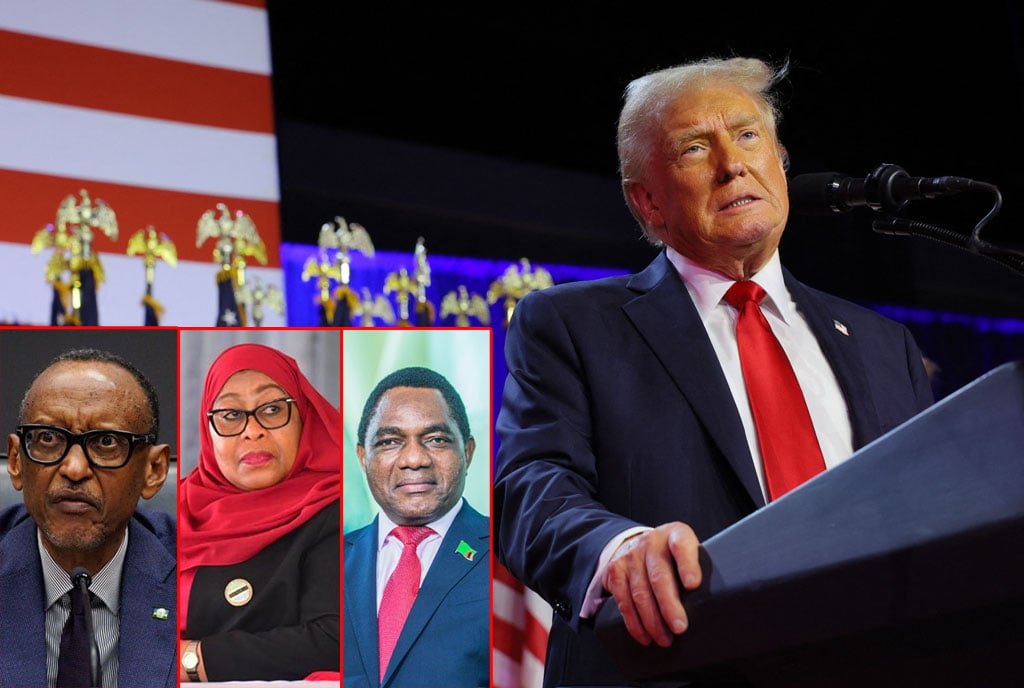Prime
Lifting the veil off the Shs78b facemask deal

The Minister of Health, Dr Jane Aceng (left), and French Ambassador to Uganda H.E Jules-Armand Aniambossou (right) receive Covid-19 doses from COVAX at National Medical Stores in Entebbe on June 16 while inset is Ministry of Health PS Diana Atwine. PHOTO/PAUL ADUDE
What you need to know:
- The Health ministry preferred to ‘cherry-pick’ contractors for the mask deal in favour of competitive bidding.
- In total, 36.3 million masks were manufactured and distributed across the country, including 3.5 million masks, which were procured and distributed over and above the population projections.
- Shs81b Amount: Initially the procurement of masks was tagged to a cost of Shs35b but at the commencement of the distribution, Dr Aceng revealed that the budget had eventually grown to Shs81b.
As one of the conditions for easing the first Covid lockdown in May 2020, Cabinet decreed that all Ugandans aged six and above wear facemasks when in public places as a measure of containing the spread of the virus.
Government undertook the provision of the masks to about 30m Ugandans. However, the budget for the masks, which was initially Shs35b, snowballed to Shs78b. The Health ministry preferred to ‘cherry-pick’ contractors for the mask deal in favour of competitive bidding.
At a total cost of Shs78.8b, it means that the unit cost of each mask was Shs2,177.
Previous news reports quoted the Health minister, Dr Ruth Jane Aceng, saying they were trying to negotiate the factory unit cost of a mask from Shs2,400 to Shs1,000.
Currently, ordinary—nonmedical—facemasks cost anywhere between Shs1,000 to Shs2,000.
One manufacturer, who requested anonymity, revealed that a unit cost of a mask for bulk purchases is between Shs350 and Shs500 depending on the quality.
The funds spent on masks also outstrip the total sum of the cash relief worth Shs54b, currently being doled out by government to vulnerable communities in the city and urban centres in the country.
Questions are also emerging on how the contracts for the masks were awarded. The Health ministry preferred to directly select contractors in the spirit of quickly procuring the masks rather than the competitive bidding method.
Among the beneficiaries of these lucrative contracts was a legal aide to President Museveni, Flora Kiconco.
Going against the values of equity, another mask deal was rewarded to Arinaitwe Kashumba and Jessica Kashumba whose company— Mmacks Investment Ltd had earlier on bagged another deal worth Shs810m from the Office of Prime Minister (OPM) to supply 180 metric tonnes of beans.
Silk Events, registered in 2007 by Elvis Ssekyanzi and Aga Sekalala Jr, was among beneficiaries of the mask deal. However, Mr Sekalala is no longer involved with company since around 2017.
In his periodic television addresses on the Covid-19 pandemic on May 18, 2020, President Museveni described mask-wearing as the safety valve to contain the spread of the pandemic.
“The masks must be worn all the time you’re in public…This is the new point of emphasis,” Mr Museveni said, and revealed that the government had decided to provide the masks to all Ugandans aged six and above, who cannot afford them.
The masks, the President indicated, would be distributed through the local government system; from the district and across the grassroots with each of the more than 30 million Ugandans entitled to one mask.
Local council chairpersons started registering their subjects for the masks, while in Kampala, the Health ministry commenced the procurement process.
The distribution commenced on June 20, 2020, starting with 750,000 masks distributed to border communities in the districts of Rakai, Amuru, Kyotera, and Adjumani.
In Lolachat Village, Pian County, Nabilatuk District, north east of the country, several residents told this newspaper that they have no idea about the masks.
However, Pian County MP Remigio Achia told Daily Monitor that some masks were distributed to his constituency barely after the first lockdown was lifted in June 2020.
“I know several villages got masks, and recently police were mounting operations to arrest those found without masks in public places,” Mr Achia said.
On May 10, 2021, President Museveni ordered for another lockdown to take the sting out of the deadly second wave, which is highly transmissible.
Even in the Karamoja Sub-region, long regarded as a rural setting, Nibilatuk is among the eight districts in the sub-region where we found some residents wearing masks.
The Covid-19 focal person for the sub-region at Moroto Regional Referral Hospital, Dr Moses Okwir, said: “They [Karamajong] are coming to test because they too have had deaths in their communities, and many are keen on wearing masks,” he revealed.
The Eastern Uganda sub-regions of Karamoja, Teso, Bugisu, Sebei, and Busoga—with an estimated population of 9.4 million people of which 7.4 million are believed to be above the age of six—received an estimated 7.6 million masks representing a 21 per cent share nationwide. The region received an extra 243,787 masks.
Masked deals
Initially the procurement of masks was tagged to a cost of Shs35b but at the commencement of the distribution, Dr Aceng revealed that the budget had eventually grown to Shs81b.

Gender minister Betty Amongi flags off mask distribution in Kampala together with Resident City Commissioner Kampala, Farida Mayanja (left), Kampala Capital City Authority (KCCA) executive director Dorothy Kisaka (2nd left) and Central Division mayor Charles Musoke Serunjogi (right) at the KCCA Central Division headquarters in August last year. PHOTO/DAVID LUBOWA
She said the unit cost of each mask— made up of 3 layers; outer layer made up of 65 per cent polyester and 35 per cent cotton, the middle layer made up of chiffon, and the innermost layer made of cotton—was Shs2,400. She, however, said they were negotiating to have the unit cost reduced to Shs1,000 as factory price.
But according to a Ministry of Finance’s Budgeting, Accountability and Monitoring Unit’s report on government’s Covid-19 expenditure, it details that by the end of March 2021, the Health Ministry had cumulatively spent Shs78.8b on the procurement of masks.
Of the Shs78.8b, Shs53b was paid during the last financial year and Shs25b paid in the preceding Financial Year of 2019/2020 when the pandemic struck.
The ministry also spent another Shs594m on the distribution of non-medical masks to various districts.
Tenders
According to the report, the first batch to manufacture 8.5 million masks was handed to Bugolobi-based Fine Spinners Ltd at Shs20.4b. Another contract to manufacture 7.5 million masks was handed to Southern Range Nyanza Ltd at a contract sum of Shs18b but the budget later increased to Shs21.6b. The company did not immediately respond to our inquiry about the variance in the price.
The third batch was handed to Graphics Systems Ltd, which received Shs10b by the end of last year.
A contract worth Shs5.2b was awarded to Mmacks Investment Ltd, a company registered in 2009 to Arinaitwe Kashumba and Jessica Kashumba. Notably, the same firm was awarded another Shs810m tender by the OPM to supply 180 metric tonnes of beans distributed to the vulnerable communities during the first lockdown.
A contract of Shs1.5b was handed to EX-KEN Uganda Ltd and another worth Shs1.1b was handed to Big Concepts Ltd, a company incorporated in 2017 and owned by Rahul Dhawan.
Fundi Building Centre received Shs985m to deliver another consignment of masks.
Batch 10 was executed by Christex Garment Industry incorporated in 2012 and whose shareholders are Chris Mutegyeki and Rosebell Bagyenda. The company was paid Shs810m. Another Lot 16 worth Shs2.9b was awarded to Winfred Fashions Ltd, whose shareholders are Hillary Arinaitwe and Winfred Arinaitwe.
Lot 12 was awarded to events promotions firm, Silk Events, the company was were paid Shs528m for the deal. Lot 15 was executed by Ever Green Safaris Ltd, whose owners are Rashida Asiimwe and Frank Waibale. They were paid Shs413m.
Youth Save the Nature Uganda Ltd executed Lot 18 for 35,267 masks, for which the company was paid Shs193m. The company’s shareholders are businesswoman Olivia Mugabe, and Ms Kiconco.
Lot 20 was handed to two entities; one, to Fine Media, a marketing agency incorporated under the names of Timothy Bukenya and Angella Nalubega, which received Shs348m, while the second to, Uganda Industrial Research Institute, to make 3 million masks at a cost of Shs9.6b.
Where are the masks?
In total, 36.3 million masks were manufactured and distributed across the country, including 3.5 million masks, which were procured and distributed over and above the population projections.
Each individual was entitled to one mask, but according to the Finance report, some local governments distributed two masks per individual. This partially led to inadequacy of non-medical masks in various communities.
The commissioner for planning in the Health ministry, Ms Sarah Byakika, explained why they experienced discrepancies during the distribution exercise.
“Often times, population figures on ground are higher than the Uganda Bureau of Statistics projections numbers that is why we procure items including mosquito nets slightly above the projections to ensure that everybody is covered,” Dr Byakika was quoted by the report.
Of the 36.3 million masks, Northern Uganda with an estimated population of 8.7 million people received 7.2 million masks, Western Uganda’s 10.1 million people received 8.6 million masks, and Central Uganda with the highest population density of 13.1 million of which 10.3 million are above of the age of six, received 12.6 million masks, including 2.2 million in excess.
“Despite the fact that all regions had excess supply of masks, they were inadequate in some districts, even those that distributed one mask per individual,” the report notes.
For instance, in Mbarara, 309,866 community masks were received but three sub-counties of Rubindo, Kashare and Bukiro did not receive any mask at all. In Rukiga, a total of 83,540 masks were received instead of the expected 83,590. Mitooma District received a total of 153,500 instead 154,094, but the 594 excess masks were unaccounted for, which is similar in Iganga, which received 303,254 instead of 306,754 community masks.
In May last year, a section of MPs criticised the single-sourcing of Southern Range Nyanza Ltd or Nytil as the contractor for the entire mask deal. They argued that for resources to trickle down to communities, some of the contracts should be given to firms at the grassroots.
But the Health ministry said the procurement was an urgent matter that required direct sourcing instead of the time-consuming competitive bidding.
A separate Finance issued last September detailed the low uptake of government masks by the population in Kampala, Wakiso and Mukono districts with communities preferring to buy those they felt were of a better standard. In the selected districts, where a majority could afford their own masks, the report indicated there was little value for money.
Between March 2020 and June 2021, the Health ministry received both budget and off budget support from various funders including World Bank, Global Fund, GAVI, among others to the tune of Shs750b, of which Shs617b or 82 per cent had been spent by March 31, 2021.
*This story was last updated on July 28 (12:50pm EAT)




